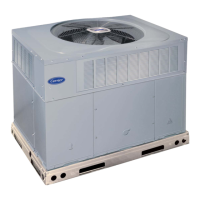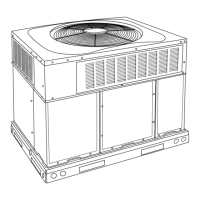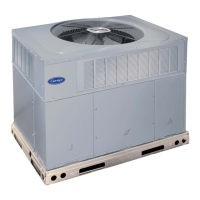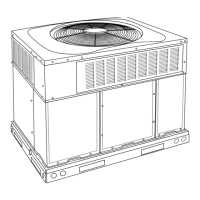Table11- ColorCodingforIndoorFanMotorLeads
Black = High Speed
Orange = Med- High Speed
Red = Med Speed
Pink = Med- Low Speed
Blue = Low Speed
Selection of Proper Fan Speeds for Operation
Modes:
NOTE: All models are factory-shipped for nominal high stage
and low stage cooling airflow operation at minimum external static
pressure. Many models are factory-shipped for nominal high stage
and/or low stage gas heating airflow at minimum external static
pressure. Tables 13 (208/230 VAC models) and 14 (460 VAC
models) provide airflow data for higher external static pressures.
Low Stage Gas Heating (208/230 VAC models): Table 13 shows
the suitability of each speed for a given external static pressure for
low stage gas heating. Any speed/static combination that is outside
the rise range is marked "NA" and must not be used. The unit must
operate within the low stage gas heat rise range printed on the
rating plate. Connect the chosen fan speed wire to "LO HEAT"
connection on the IGC Board (see Fig. 20).
High Stage Gas Heating (208/230 VAC models): Table 13 shows
the suitability of each speed for a given external static pressure for
high stage gas heating. Any speed/static combination that is outside
the rise range is marked "NA" and must not be used. The unit must
operate within the high stage gas heat rise range printed on the
rating plate. Connect the chosen fan speed wire to "HI HEAT"
connection on the IGC Board (see Fig. 20).
Gas Heating (460 VAC models): Table 14 shows the suitability of
each speed for a given external static pressure for gas heating
operation. Any speed/static combination that is outside the rise
range is marked "NA" and must not be used. The unit nmst operate
within the gas heat rise range printed on the rating plate. Connect
the chosen fan speed wire to "GAS HEAT" connection on the
Interface Fan Board (IFB, See Fig. 21).
Low Stage Cooling (All models): Using Tables 15, 16, and 17,
and the nonfinal airflow for low stage cooling (Table 1) find the
external static pressure drops for wet coil, econonfizer, and filter,
and add them to dry coil measured on the system. Using this total
static pressure, use Table 13 (208/230 VAC models) and Table 14
(460 VAC models) to find the airflows available at the total static
pressure. For 208/230 VAC models, connect the chosen fan speed
wire to "LO COOL" connection on the IGC Board (see Fig. 20).
For 460 Vac models, connect the chosen fan speed wire to "LOW"
connection on the IFB (see Fig. 21).
High Stage Cooling (All models)Using Tables 15, 16, and 17,
find the external static pressure drops for wet coil, econonfizer, and
filter, and add them to dry coil measured on the system. Using this
total static pressure, use Table 13 (208/230 VAC models) and
Table 14 (460 VAC models) to find the airflows available at the
total static pressure. The speed chosen nmst provide airflow of
between 350 to 450 CFM per ton of cooling. For 208/230 VAC
models, connect the chosen fan speed wire to "HI COOL"
connection on the IGC Board (See Fig. 20). For 460 VAC models,
connect the chosen fan speed wire to "HIGH" connection on the
IFB (see Fig. 21).
High Stage Enhanced Dehumidification Cooling (208/230 VAC
Models): Using the total static pressure for selecting the high stage
cooling speed, use Table 13 to find lower speed/airflows available
at that total static pressure. All airflows highlighted in Table 13 are
acceptable for Dehum speed. The speed chosen must provide
airflow of between 320 to 400 CFM per ton of cooling. For
208/230 VAC models, connect the chosen fan speed wire to
"DHUM" connection on the IGC Board (see Fig. 20).
To activate the high stage enhanced dehunfidification cooling
mode, the shunt jumper in Fig. 20 nmst be moved from the No DH
to DH selection (See Fig. 20, close up).
Continuous Fan (All models): Continuous fan speed is the same
speed as Low Stage Cooling.
Using the Same Fan Speed for More than One Mode: Some fan
speeds are ideal for more than one mode of operation. It is
pernfissible to use a field-supplied jumper wire to connect one
speed tap wire to two or more speed connections on the ignition
board (IGC). Jumper wires must use 18 AWG wire with at least
2/64" insulation.
Cooling Sequence of Operation
a. Continuous Fan
(1.) Thermostat closes circuit R to G energizing the
blower motor for continuous fan. The indoor fan is
energized on low speed.
b. Cooling Mode
(1.) Low Stage: Thermostat closes R to G, R to Y1.
The compressor and indoor fan are energized on
low speed. The outdoor fan is also energized.
(2.) High Stage: Thermostat closes R to G, R to Y1, R
to Y2. The compressor and indoor fan are ener-
gized on high speed. The outdoor fan is also ener-
gized.
Shunt in no I IShunt in
dehumidification | Jdehumidification
position position
A13017
Fig. 20 - Interface Fan Board (IFB) 208/230 VAC Models
32

